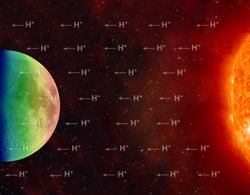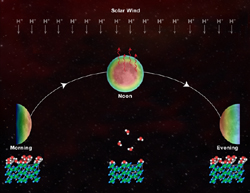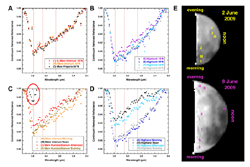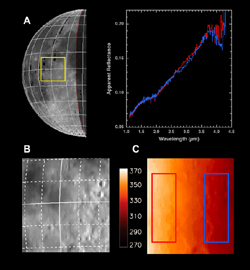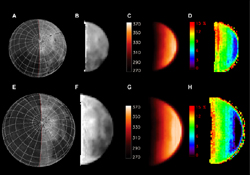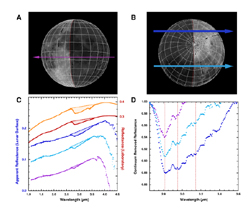EPOXI
Two intriguing investigations -- One flight-proven spacecraft
EPOCh Science
Deep Impact and Other Spacecraft Find Clear Evidence of Water on Moon: Thin layer of surface 'dew' appears to form, then dissipate each day
COLLEGE PARK, Md. - Just published data from the Deep Impact spacecraft and the Moon Mineralogy Mapper (M3), an instrument aboard India's recently ended Chandrayaan-1 spacecraft, provide, for the first time, clear evidence that water exists on the surface of the Moon.
"The Deep Impact observations of the Moon not only unequivocally confirm the presence of OH/H2O on the lunar surface, but also reveal that the entire lunar surface is hydrated during at least some portions of the lunar day," write University of Maryland astronomer Jessica Sunshine and co-authors in a paper on the Deep Impact data published online in the September 24 issue of the journal Science.
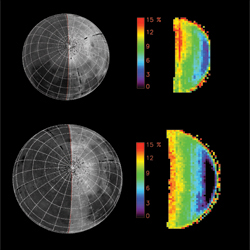 Click for larger image.
Click for larger image.
Fig. 1: Two sets of observations over the North pole separated by one quarter of a lunar day. Hydrogen is detected on both dates at all observable locations (>10°N). The temperature maps (right) are derived from >4µm spectra and compared to Clementine basemaps (left) of the observed areas.
top panel: 2 June 2009, ~80km/pixel
bottom panel: 9 June 2009, ~60km/pixel)
Small Amount of Water Yields Big Excitement
"Finding water on the moon is a big deal, even it is only a small amount of water and only in the form of molecules stuck to soil and rock," said Sunshine, lead author of the Deep Impact paper and a co-author of a companion Science paper based on data from the M3 instrument that first detected the presence of lunar water. Prevailing scientific opinion long has been that there probably is no water on the Moon and that, even if it does exist, it would be only in permanently cold, shadowed craters at the lunar poles.
"In the Deep Impact data we're essentially watching water molecules form and then dissipate right in front of our eyes," said Sunshine, who said her first reaction to the data was: "It can't be, it can't be!"
"We aren't certain yet how this happens," she said, "but our findings suggest a solar driven cycle in which layers of water only a few molecules thick form, dissipate and reform on the surface each lunar day. We postulate that hydrogen ions from the sun are carried by the solar wind to the moon and there interact with oxygen rich minerals in lunar soil and rock to produce the water [H2O] and hydroxyl [OH] molecules that spectral analysis clearly show us is there. This water is formed in the morning and then by lunar mid-day heat from the sun causes the molecules to evaporate.
"If this is correct, then such hydration via solar wind would be expected to occur throughout the inner Solar System on all airless bodies with oxygen-bearing minerals on their surfaces," Sunshine said.
And while some other scientists may offer different hypotheses, the enthusiasm for the current finding among planetary scientists seems nearly universal. "Water ice on the moon has been something of a holy grail for lunar scientists for a very long time," Jim Green, director of the Planetary Science Division at NASA Headquarters in Washington said in a NASA release.
Another reflection of the scientific significance of finding water on the moon is that it generated three papers in the current issue of Science and a NASA press conference. In addition to the M3 and Deep Impact articles, a third Science paper presented evidence collected by NASA's Cassini spacecraft.
Lunar H2O Latest in UM-Led Deep Impact Science
Although the M3 instrument and its science team made the initial discovery of water in certain areas of the lunar surface, Sunshine and co-authors on the Deep Impact paper said the conclusiveness of the finding of water, the realization it was a surface-wide phenomenon, and the insight into the temperature dependent nature of the process were only possible because of data collected by the Deep Impact spacecraft during it's current extended mission (EPOXI). Deep Impact was not designed to study the moon, but for a famous 2005 mission in which it successfully knocked a hole in comet Tempel 1 to find out what was inside. Its data on lunar water were obtained as part of calibration opportunities that occurred during June flybys of the Earth and Moon needed to get adequate gravity boosts to travel on its EPOXI mission to a second comet, Hartley 2, which the spacecraft will encounter in November 2010.
"Without the spectral range of Deep Impact's instruments the M3 discovery of surface water would not have been nearly so definitive, and because the Deep Impact spacecraft took observations on two different flybys at different times of the lunar day, the effect of temperature became very apparent," Sunshine explained.
University of Maryland Astronomer Michael A'Hearn, Deep Impact and EPOXI science team leader and one of Sunshine's four Maryland co-authors on the Deep Impact paper in Science, said "I think it is tremendous that the Deep Impact spacecraft, which was the first to detect ice on a cometary nucleus, has now demonstrated the existence of adsorbed water on the moon."
"This great spacecraft and its instruments continue to make important, unexpected discoveries long after the prime mission has ended," he said.
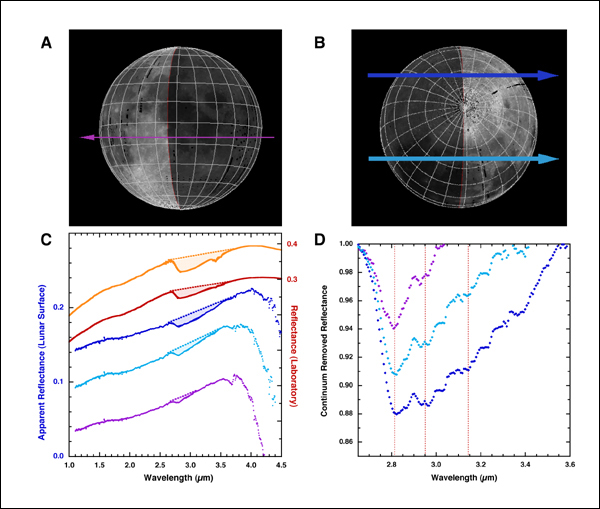 Click for larger image.
Click for larger image.
Fig. 2: High signal-to-noise reflectance spectra of the average response along a chord of the Moon acquired as Deep Impact scanned rapidly across the Moon.
(A) Location of the equatorial chord (purple arrow) acquired on 29 December 2007 over a 750 nm Clementine basemap (15° grid). Arrow width indicates size of spectrometer slit.
(B) Locations of two chords acquired on 2 June 2009 at mid-latitudes toward the morning (cyan arrow) and evening (blue arrow) sides.
(C) Spectra of the three chords as compared to laboratory data of two lunar soils (14259 red; 62231 orange). Continua over the 3µm region (dashed) reveal absorptions due to hydration (shaded regions) similar to hydration features in the laboratory data (some, if not all of which is terrestrial in origin).
(D) Continuum-removed spectra of the 3µm regions of the Deep Impact chord spectra. The three major OH and H2O absorptions near 2.8, 2.95, and 3.1µm are indicated (dotted red lines).
Additional Links
- Article in Science: Abstract
- Article in Science: Full Text
- NASA Press Release
- UM Press Release
- NASA M3 Results


